Moises had told us the advisor would arrive between 0630 and 0700. Christi was up at 0500 with another round of severe tummy sickness. At 0600, everyone else got up. Interestingly, as soon as she was “on” again, her tummy sickness almost instantly went away. But, her allergies were unhappy today, too, so she was sneezy and sniffly all day.
As soon as everyone else was up, Christi made coffee, put out food for breakfast, and did dishes. Everyone helped with folding sheets and tidying up so Kosmos looked like a boat again instead of a dorm room. Outside, all was tranquil and placid in the early morning light. There were 11 big ships in the anchorage with us. The first shot is of our giant mooring and the second is of the surroundings.
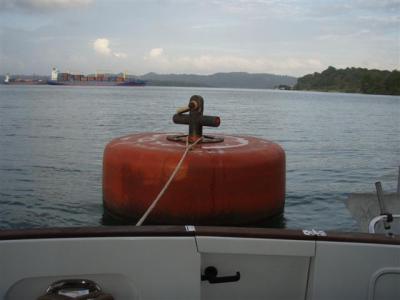
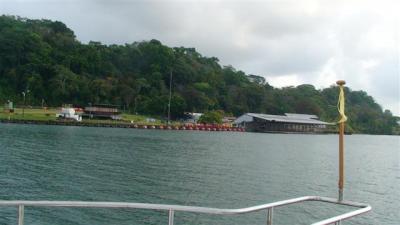
The advisor arrived close to 0800. Today’s advisor is named Davidson, and he is just as pleasant of a person as Moises.

He got right to business with a quick orientation, then instructed us to get underway. By 0815, we had cleared the moorings and were headed for Banana Cut, a shortcut for small boats off of the main channel. It is only 3 nm shorter than the main channel, but the real benefit is there are no big ships to have to worry about in there. Banana Cut is also supposed to have a lot of wildlife that you can see from the boat.
We were scheduled to enter the first lock at 1130, and we would be in the lock all alone. However, we anticipated it would take us four hours to cross the lake at our normal cruising speed, so we needed to hustle along at top speed to make it. Shortly after we left, Davidson radioed over to the control tower and was able to change our appointment to 1230. We’d be sharing a lock with another vessel, which was fine by us. Phew. That took a lot of stress off.
We turned into Banana Cut. There is a line of buoys that clearly mark the channel. It is serene and peaceful, with lots of small islands and foliage sticking up out of the water. The jungle is lovely and it was a pretty ride. There were no other boats in the Cut, either, so it kind of felt like we were taking a leisurely cruise in an isolated paradise. We all kept an eye out for jungle animals. Susan had binoculars and she did see a few birds, including ospreys, frigates, roosting black hawks and black vultures. But even she could barely see them through the binoculars and no one could see them with the naked eye. No one else spotted anything.
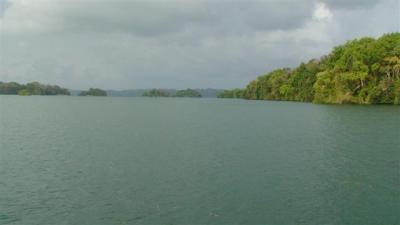
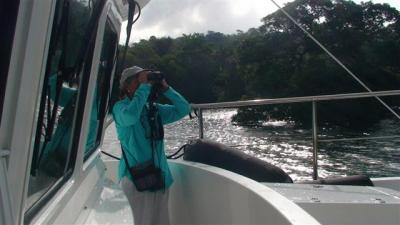

A little before 0900, we could see tankers crossing up our path up ahead and knew it had to be the main channel. At 0905, we turned into the main channel. There wasn’t a ton of big ship traffic, but we did have a steady flow of ships passing from the other way, and a few overtook us from behind. When no ships were around, Eric would sometimes steer with his toes, but when ships were in sight, he immediately sat up and steered with his hands. The crew was very amused by his toe steering, thinking he was joking around, but the reality is we toe steer probably more than we should admit to. The autopilot dial is just in the perfect spot to be reached by our feet as we recline in the pilot chair.
Jeff did an engine room check and reported that our shaft packing was a little hotter than normal and that our brand new blower had stopped working. Sigh. Eric remembered that in fresh water the shaft runs hotter for some reason.
We passed an island that had a bunch of earth moving equipment actively being us on it. Davidson explained that the island was being removed to make the channel wider. First, they had moved all the wildlife off of it. Now they are removing all the loose dirt, and eventually they will dynamite the last of it to smithereens.
At 0920, we passed the Smithsonian’s primary site for the study of lowland moist tropical forests. The facility is located on the island of Barro Colorado, which, along with some peninsula tips near the island, make up a 5400 hectare nature preserve. The Smithsonian administers the preserve, in addition to doing research.
At 1035 we passed through the tiny town of Gamboa, which is located where the Chagres River feeds into Gatun Lake, and is basically right on the continental divide between North and South Americas. Gamboa was originally settled by canal workers who were displaced when the town they were living in went under water as part of the canal progression. The Panama Canal’s dredging division offices are located here and it is a popular bird watching destination. We passed a barge that Davidson told us is an explosives barge, used in conjunction with making the channel wider. We also passed a huge crane that Davidson said is used for lifting the canal gates. The gates are 7 feet thick and range between 47 and 82 feet high, depending on which lock it is on.
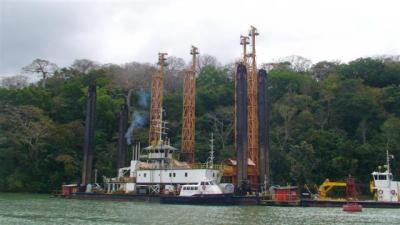
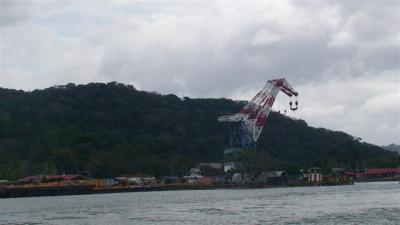
We passed a small compound. Davidson told us it was a prison originally built by the Americans and still used by the Panamanians for white collar criminals. It is apparently a controversial place because the prisoners have been known to have laptops, big screen TV’s and other such luxuries that you aren’t supposed to have in prison.
At 1105, Davidson suddenly told us to stop. He said there was going to be a controlled demolition explosion up ahead. At first we were a tad nervous about an explosion in front of us, until we realized how far away the explosives barge was. We were definitely far enough back to not be at risk, so knowing we were safe, we could sit back and enjoy the show. There was a big ship coming from the other way, and we had to wait a few minutes while it passed by us. A couple minutes after the ship passed, there was a huge boom and water went shooting up sky high, like a geyser. Davidson said there would be a second one, and we all watched in eager anticipation. But, it didn’t happen. After a few minutes, he got a call on the radio saying we could proceed.
At 1120, near Gold Hill, Edgar and Joel spotted a Three Toed Sloth swimming across the canal. Susan got a good look at him with her binoculars, but no one else was able to catch a glimpse at him. Gold Hill is a massive headland scored with cuts from the canal widening project.
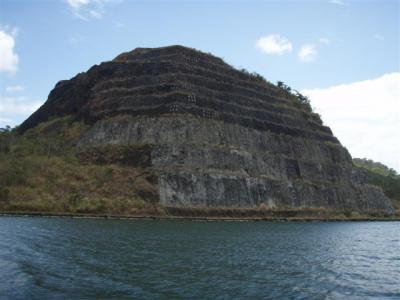
It is very close to the Centennial Bridge, which was built in 2004 to help relieve the inordinate amount of traffic on the Bridge of the Americas. Here are Tom and Susan with the bridge in the background. It was weird to think that at that moment we were literally right in the middle of the continental divide.
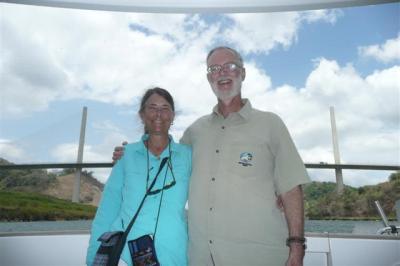
At noon, were approached the Pedro Miguel lock.
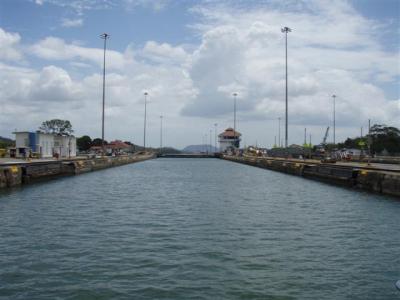
This is a single lock, which will take us down about 30 feet (9.5 meters). Davidson told us to go right in. We would get situated and then wait for the boat sharing the lock with us, who would be behind us. We were center lock again, so we all were pretty good at the routine by now. We pulled up to the finger and the handlers on shore threw us our lines. Once our handlers aboard were ready, we progressed forward into the chamber, stopping close to the gate. By 1215 we were secured and ready. Here is the view from the front seat.
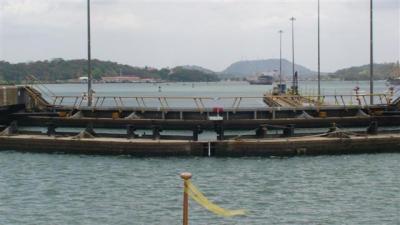
Yesterday we hadn’t noticed the ships in the set of locks next to us, probably because we were so absorbed in our own transit. But here, we sat back and watched a huge ship that basically filled up the entire lock all by itself pull in and get situated in the same manner that Pacific had yesterday.
We waited for about 15 minutes before we saw the ship that would be sharing the lock with us approaching in the distance. Jeff did another engine room check and found our new blower had magically started working again all by itself. But the shaft packing was still hot.
When it got to the edge of the lock, the little rowboat went out and did its thing. We could see it is named Century Pearl. Oh, Century Pearl was in the anchorage with us last night! When the cables were situated, Century Pearl pulled forward into the chamber and stopped behind us. At 1255, the gate shut. Almost immediately, the water level started going down. It happened so fast we hadn’t even realized we were moving down until Davidson pointed it out. It went down much faster than it went up. At 1305, the lowering was complete and the gates opened. The gates also opened much faster than they opened yesterday. Look at how much lower we are now than compared to the last photo!
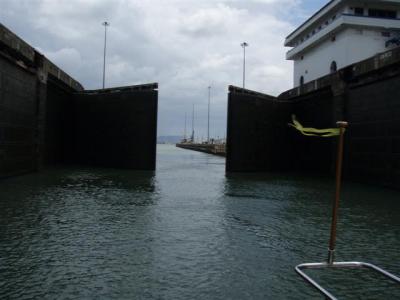
The line handlers on shore dropped the lines, and we pulled forward into a small lake.
At 1320 we arrived at the Miraflores Lock, which is a set of two locks, and the final descent into the Pacific Ocean. We were told to wait a few minutes before we could enter. The wind had picked up to 20 knots and the water was choppy.

The large crane may be nicked named “Herman the German” It’s been down on the ditch forever. I transited the canal aboard a cruise ship in May 2000. A few years later I was back down that way and and made the transit via train, two very different perspectives of the canal.
Regards,
tb